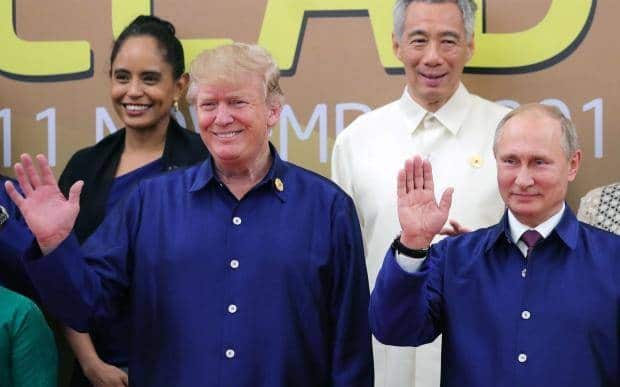Donald Trump and Vladimir Putin wave at the Asia Pacific Economic Cooperation summit in Vietnam, November 2017 (Sky)
Originally published by The Conversation:
At face value, Donald Trump’s announcement about his plans on Russia and Ukraine look like a major policy change. Speaking from the Oval Office on July 14, where he had been meeting with NATO Secretary General Mark Rutte, the US President said he will send “top-of-the-line-weapons” to help Kyiv and – unless a ceasefire deal is agreed inside a 50-day time limit – the US will impose secondary sanctions on any countries dealing with Russia.
But while this represents a significant departure from Trump’s previous approach, it’s more of a step back towards the policy approach of his predecessor Joe Biden than the U-turn that some commentators are claiming.
For months Russia has stepped up its bombardment of Ukraine, buoyed by the fact that neither the US Congress nor the White House has authorised any new military aid to Kyiv. Moscow would have been aware of this lack of US action and its missile and drone attacks against Ukraine have aimed to run down the stocks of air defense missiles supplied by Biden while paying lip service to the idea of peace negotiations.
For Trump the penny appears finally to have dropped as to what was happening. His frustration and disappointment in Putin is what has finally led to him calling this out. According to Trump, Putin “fooled a lot of people – Clinton, Bush, Obama, Biden – he didn’t fool me. At a certain point talk doesn’t talk, it’s got to be action.”
The decision to send new supplies of defensive and potentially even longer-range offensive missiles to Ukraine, even if the Europeans pay for them, is an important signal to Russia. But so too is the threat of tariffs of 100% on countries, such as India and China, that sustain the Russian economy by buying its oil and gas at knockdown prices.
The US senate, led by Lindsey Graham, the influential Republican senator for South Carolina, has been itching to pass these secondary sanctions for months. Now that the Trump Administration appears to have adopted this plan, it is a significant policy instrument to pile the pressure on Russia.
The change in Trump’s approach may also mean that the $8 billion of frozen Russian assets in the US — and $223 billion in Europe — could be released to aid Ukraine, which would provide a ready means to pay for the US arms transfers.
Limits to US support
What has not changed, however, is the goal of Trump’s policy towards the war in Ukraine. While the Biden Administration called out the illegality of Putin’s unprovoked aggression and called for the restoration of Ukrainian sovereignty, Trump is merely calling for a ceasefire.
Trump may say he is “disappointed” with Putin, but he has not labelled him as the aggressor. In fact at one point he was blaming Ukraine for the invasion. And, significantly, he has not demanded that Russia give up the 20% of Ukraine that it currently illegally occupies.
The US President is also silent on what the US would commit to in terms of security and stability for Ukraine after the fighting stops. This is a much bigger question than Ukraine’s NATO membership. America’s European allies in Nato regard some sort of stability force on Ukrainian territory as necessary to deter any future Russian aggression.
Whether or not US troops would be involved (and all the signs are that they would not), some sort of US security “back-stop” or guarantee is still seen in Europe as key to its success – as would be US logistical and intelligence support for its operation.
But Why the 50-Day Delay?
Another aspect of the change in Trump’s policy is the long lead time that Russia has been given to come to the table. A lot of Ukrainian civilians are likely to die during this period if the intense bombardment continues. On the battlefield, 50 days would give the Russians an extended window during a renewed summer offensive to make further territorial gains inside the occupied provinces.
So Trump’s proposals have to be viewed through the prism of his propensity to set deadlines that are then pushed back multiple times – as with the on-again, off-again tariffs, which have given Trump the nickname TACO (“Trump Always Chickens Out”) on Wall Street.
Russian senator Konstantin Kosachev was certainly taking this view when he told the BBC after Trump’s announcement, “If this is all Trump had to say about Ukraine today, then so far it’s been much ado about nothing”.
This sentiment was shared by the Russian stock market which rose 2.7% in the aftermath of Trump’s announcement. Analysts had expected much worse, so the long delay in the prospect of anything actually happening was clearly seen as a long way off and potentially subject to change or cancellation. Trump is seen by many as both inconsistent in his threats and unpredictable as to where policy will eventually settle.
The fact that Trump told BBC Washington correspondent Gary O’Donoghue that while he was “disappointed” with Putin, he was “not done with him” – and his clear reluctance to act quickly and decisively in sanctioning Russia – should be seen as an important counterpart to the apparent policy shift.
Like so many things with the 47th US President, it’s important not to react to the media appearances or the headlines they provoke, without also paying attention to the policy and actions of his administration.


[Editor’s Note: Neither Professor Dunn nor I are stunned — especially not by the level of propaganda and falsehood from some to justify the Russian invasion of Ukraine.]
**************
The following question should be asked: Was Russia provoked into invading Ukraine? NATO governments said Russia’s invasion of Ukraine was unprovoked, and the mainstream media in NATO countries repeated the charge ad nauseum. We need to know more about the discussions that took place at the summit in Geneva in 2021 (openly and privately) and the exchanges between Foreign Minister Lavrov and Secretary of State Antony Blinken in December 2021. It is clear that the Russians misread or misjudged the Biden administration and its intentions regarding Ukraine.
[Editor’s Note: Neither Professor Dunn nor I are stunned — especially not by the level of propaganda and falsehood from some to justify the Russian invasion of Ukraine.]
The post-Cold War era really was what Boris Yeltsin said it was — a ‘cold peace’. Why are policymakers and academics surprised that a long cold peace ended with a hot war? Professor Dunn and Professor Scott Lucas are stunned. They couldn’t imagine a new security architecture for Europe, and neither could the policymakers. Western policymakers in the 1990s had no strategic vision for a peaceful and secure Europe, and there weren’t any voices in the Ivory Tower to turn to for guidance. Those former Warsaw Pact states joined NATO not to ensure their own security, but to spite Moscow. Academics in the West celebrated that. Well, here we are. It really is tragic.
Many years ago, Professor John Mearsheimer of the University of Chicago said that Ukraine would get “smashed” if US and NATO policies didn’t change. The voice crying out in the wilderness.
“Trump may say he is “disappointed” with Putin, but he has not labelled him as the aggressor. In fact at one point he was blaming Ukraine for the invasion. And, significantly, he has not demanded that Russia give up the 20% of Ukraine that it currently illegally occupies.”
*********
Does Trump believe Putin is the aggressor, or does he believe that Russia’s invasion of Ukraine is defensive in nature? Does Trump believe that the policies of his first administration, the policies of the Obama administration, and the policies of the Biden administration destabilised Ukraine and provoked Russia? Trump said that no US president in the post-Cold War era was tougher on Russia than he was. The illegal sanctions on Russia, the Obama administration’s violations of the Vienna Convention (seizure of diplomatic offices in the US), the militarization of Ukraine ,Trump’s decision to send offensive weapons to Ukraine during his first term – weapons that were used against the rebels in the breakaway regions, the chemical and biological labs in Ukraine that Victoria Nuland admitted to in a testimony in Washington, the decision bring Ukraine into NATO, future plans to deploy NATO missiles in Ukraine.
You and your colleagues should discuss the root causes of the conflict. If you give your readers more information and analysis, and are impartial and objective with that analysis, we can think critically about the conflict and hopefully come up with solutions. You and your colleagues know that none of this started with Vladimir Putin. Boris Yeltsin said that the security architecture in Europe was biased against Russia; his concerns were ignored, and that was one of the reasons why Putin succeeded him.